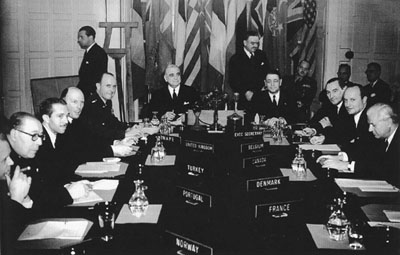The leading historian of the event called it a Second American Revolution, radically transforming United States foreign policy. It was no less a revolution for Canada. North America was engaging itself in the security of Europe for the long haul.

|
| Louis St. Laurent was a prime architect of Canada's international policies after WWII and promoted Canadian membership in NATO (courtesy NAC/C-8099/copyright Bill and Jean Newton). |
External Affairs minister L. B. Pearson signed Canada's first peacetime military alliance on that brilliant spring afternoon, stating that it was born out of fear, frustration and hope.
Fear of the military might of the Soviet Union, at the head of an aggressive, subversive communist juggernaut on the move.
Frustration that the United Nations had fallen so short of its original aims and dreams, and could not be relied on as an organization for the protection of its members.
But hope, too, that the North Atlantic Treaty could be a pact for peace and progress, not a narrow and old-fashioned military alliance. A pact, furthermore, that would prevent an American retreat into isolationism or a resort to unilateralism.
Before 1939, Canada had been a dry, cautious place, dragged down by the Depression and chary of a role in the world. Yet the hermit nation contributed mightily to victory in the Second World War, putting one of every ten Canadians in uniform and pouring food and weapons and economic assistance into the allied cause.
Canada came out of the war buoyant, with a powerful economy and a realization that the world was too small to allow a return to a pinched past. The country was united at home and at the height of its international influence. It had the finest medium-sized foreign office in the world, the Department of External Affairs, which supplied Canada's strategy for the North Atlantic Treaty discussions.
Canada was one of the treaty's three initiators, along with traditional partners Britain and the US. Louis St. Laurent, who preceded Pearson as foreign minister, had been among the first public advocates of a regional defence arrangement, telling the United Nations in the late summer of 1947 that it had become "frozen in futility and divided by dissension." Democratic and peace-loving states were being driven in the direction of forming their own association with more specific obligations to ensure security.
Pearson, then St. Laurent's deputy, had worked through the night in his New York hotel room to craft the speech. He remembered that the words of the respected Quebec politician-soon-to-be-prime-minister "gripped the attention of the world assembly."

|
| Founding members of NATO, 1949 (Hulton Archives, HB-7277). |
Initiators became negotiators. Canadians were present at the creation of the treaty document, and were key drafters of Articles 4 and 5, dealing with consultation and obligations. Article 2, moreover, was the result of sheer Canadian insistence and perseverance. It summoned alliance members to improve themselves and each other politically, socially and economically. The argument behind the "Canadian article," its instant nickname, was that there must be the development of a genuine North Atlantic community if the alliance was to endure and reach out to find the better, safer ground of a sane and moral world. It was inspiring stuff, and St. Laurent and Pearson meant every word of it.
Canada was more significant at mid-twentieth century than it was before or could be now. But a remarkable aspect of the North Atlantic Treaty Organization's more than fifty-year story is that, after an initial burst of commitment that carried its military to Europe on a wave of defence spending in the early 1950s, Canada let its security-building enthusiasm wane.
Canada preferred to regard NATO as a political arrangement, doing only as much militarily as was necessary to maintain a modicum of credibility inside the alliance. Nor did it press hard to turn the Atlantic Alliance into an Atlantic Community, as Article 2 and its Canadian champions had promised.
Witness Prime Minister Pierre Trudeau's 1969 decision to withdraw half of the Canadian force from NATO Europe, and the malnourishment of the military which has followed over the decades since.
All those who are lining up to write the country off as internationally invisible and irrelevant at the beginning of the twenty-first century will find rich ammunition in the long neglect of an alliance Canada helped to found and shape in the brief moment when it really mattered in the world.

 Share on Facebook
Share on Facebook Share on X
Share on X Share by Email
Share by Email Share on Google Classroom
Share on Google Classroom